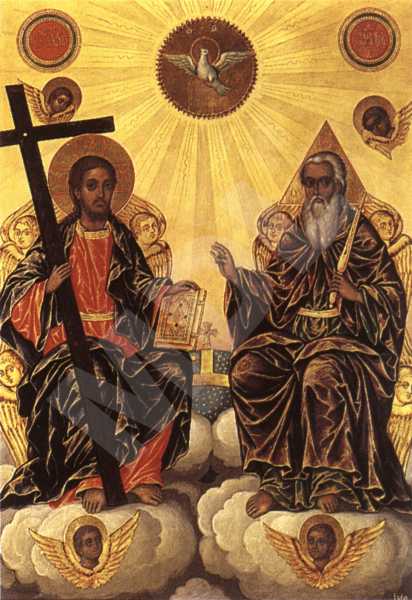The New Testament Trinity
Type:
Icon
Period:
1860 year
Born in Bansko. Had studied painting under Dimiter T. Molerov. Among his earliest works is the icon "Thomas Sees and Believes"in the "Saint Dimiter" church in Kyustendil. There is an inscription on it, reading as follows: "1896 January 16 M.Y.G. from Bansko". Of interest are the frescoes in the "Saint Archangel Michael" church in the village of Leshko. Who had b.een the painter of these frescoes is certified by a donor's text on the altar's eastern wall, which reads: "Iconographer Myalko Yuvanov from Razlog, village of Bansko, 1889". There is a rich imagination put in these frescoes, some of them having been painted in an extremely naive manner, but that entire primitivism impresses with its enhanced graphicness, intermingled with painting. The subject matter in the narthex is of a moral and everyday-life character, depicting the woman-sorceress, the woman-fornocatress, the seven-headed monster from the Apocalypse, the righteous and sinful confession, the seven sins. His are also the frescoes from 1893 in the "Saint Dimiter" church in the village of Marulevo, built in 1860. Their donor's text reads: "Iconographer Myalko Yuvanov from Razlog, village of Bansko, 1889". Mihalko Ivanov Golev had been working in the area of Sandanski, Petrich and Blagoevgrad. In many cases this had been in a team of fellow-iconographers. Together with Dimiter Sirleshtov and Kostadin Marunchev he had frescoed the "Holy Mother of God" church in the village of Stoimirovo. The inscription reads as follows: "Iconographers from Razlog, village of Bansko, Dim. and Mih. and Kost. 1909, May 30". In 1909 Mihalko Golev had frescoed the "Saint Dimiter" church in the village of Palatovo. Preserved are many pen-and-wash drawings of his, which he had been making on the pages of old account books. Preserved have been 30 sheets, 23/39 cm in size, from one such account-book. Of greater interest among these drawings is a sketch for the icon "The Entry into Jerusalem". Below it we read this text: "1868 Mihalko Golev". On these drawings he had noted in words the colours of the garments, of the objects and of the architectural volumes. These notes are a valuable information, from which we today learn about the pigments with which the iconographers from Bansko had been working. Two notebooks of Mihalko Golev with representations of saints and of various biblical scenes had been kept by his trainee and partner Dimiter T. Sirleshtov. He had bought one of the notebooks and had later on left the note: "1857 March 7, this notebook from Mihail loan Teodor Golev from Bansko, icon-painter, for 7,20 grsh." In that same notebook Dimiter T. Sirleshtov had made drawings mostly of his compositions of icons. Mihalko Golev had died in Bansko.
Dimmensions (cm):
70
/ 52.5
/ 2
Location
Country: Bulgaria
Province: Blagoevgrad
Town: Bansko
Church: St. Trinity
Source
Country: Bulgaria
Province: Blagoevgrad
Town: Bansko
Church: St. Trinity
Description
A traditional iconographic treatment of the theme. God the Father and Jesus Christ are portrayed seated on fluffy white clouds. There are around them flying little seraphs. God the Father is holding in his left hand the Scepter of victory, and with his right hand he is blessing. Christ has in his left hand a closed book and in his right one - a cross. Between the two of them there is a flying dove - the symbol of the Holy Spirit, streaming from the aureole of which is a radiance. On its both sides there are two medallions with the initials of the Holy Trinity.
Iconographical technique: Tempera
With velaturas. The painting layer is unusually well preserved. The varnish cover is applied thinly and evenly. The rich gilding is with gold-leaf, by using also the "probaster" method.
Base material: Wood
The icon's base is a one-piece softwood panel, reinforced with two inserted beams. The ground coat is laid thinly and evenly.
State, restoration traces and comments
There are no traces of any previous restorative intervention. Inscribed in the icon's lower right corner is the year when it had been made: 1860.


